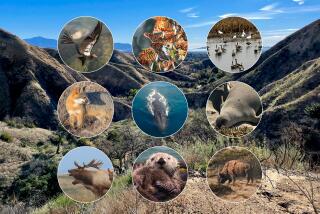Back in a Big Way
They’re here in droves this year--the monarch butterflies, those intrepid travelers that laze away the winter months at select coastal spots in Ventura County and elsewhere.
The last few years have been rather ho-hum for butterfly fans. But this year, maybe because of El Nino-driven weather conditions, a much-larger-than-usual migration of the orange- and black-winged beauties has flown in.
You’ve probably already spotted them fluttering about. If you want to see big clusters of them, hundreds or thousands at a time, you can head for a couple of primo spots on your own or join a guided group.
Along the California coast are about 300 monarch wintering sites between Marin County and San Diego, according to David Marriott, who runs the Monarch Program in Encinitas near San Diego. A dozen sites are in Ventura County, but most are on private property.
But two spots are easily accessible to the public: Camino Real Park in Ventura and Big Sycamore Canyon in Point Mugu State Park. At both locations you can find these darlings of the insect world yourself, without too much traipsing about. To get the full rundown on these creatures, you can tag along with an expert and find out more about how the monarchs make what seems like an impossible journey.
Naturalist Susan Williams leads Ventura’s butterfly outings at Camino Real Park. There, the monarchs hang out in a grove of eucalyptus trees in the barranca near the tennis courts. The best time to see clusters of them hanging from branches like grapes is early morning or late afternoon.
“Midday they’re flitting around looking for nectar,” said Williams, who supplies spotting scopes and binoculars to those who join her.
In a good year, the butterflies at this site number 20,000 to 30,000, Williams said. In bad years they dip to about 2,000.
“This is supposed to be a real good year for monarchs,” she said. “They are definitely here, and in pretty good numbers.”
One advantage to accompanying Williams is that she can lead you right to them. Hanging in clusters with their wings folded up, they are camouflaged, and sometimes to the untrained eye they look like a bunch of leaves.
Williams is leading four family outings at Camino Real Park: Nov. 29, Dec. 20 and 27, and Jan. 10. They all run from 9:30 to 11 a.m. and cost $4. Children should be at least 5 years old, and preregistration is required.
If you want more of a coastal experience, head for the entrance to Big Sycamore Canyon off Pacific Coast Highway. You won’t have to trek into the canyon to find the monarchs, although it’s a pleasant day hike. They cluster in the trees near the camping area for bicyclists.
California State Parks offer three free butterfly outings here. The one-hour guided walks are scheduled Nov. 29, at 3 p.m.; Dec. 13, 11 a.m.; and Dec. 30, 2 p.m. No preregistration is required, and participants should meet at the Sycamore Canyon entrance station.
Farther down the coast, Leo Carrillo State Beach is another good spot for monarch viewing. Rangers can point you toward the butterflies’ favored eucalyptus groves.
Butterfly experts are thrilled with the bumper crop of monarchs. They plan to do a count around Thanksgiving when the season peaks.
“This year we could see the highest populations ever recorded,” Marriott said.
Just why is unclear, but El Nino may figure into it. Heavier rainfall than usual in the Pacific Northwest produced a hefty amount of milkweed plants, the monarchs’ preferred cuisine.
“If the milkweeds do well, the butterflies do well, as long as a big winter storm doesn’t hit,” said Walter Sakai, a Santa Monica College biology instructor who tracks butterfly colonies. He’s not too quick to point to El Nino. “Just about everything from now on is being blamed on El Nino.”
If you join a guided butterfly outing, you’ll learn some amazing facts about the monarchs. In late October or early November they begin their migration from points north to escape winter. In a typical year, millions wing their way to Southern California and Baja. Those east of the Rocky Mountains head for a small mountainous spot in Mexico.
Amazingly, they target the same groves of eucalyptus trees each year. By March, they are ready for the return trip. But the miraculous thing about this journey is that the life span of a monarch is as short as one month or as long as seven months. That means that none makes the complete round-trip to guide the others. Just how they find their way back and forth has baffled scientists for years.
BE THERE
Local--To sign up for Ventura’s four butterfly outings at Camino Real Park, Dean Drive and Varsity Street, call 658-4726.
State--For more information on the three butterfly programs at Big Sycamore Canyon in Point Mugu State Park, call (818) 880-0350.
More to Read
Sign up for The Wild
We’ll help you find the best places to hike, bike and run, as well as the perfect silent spots for meditation and yoga.
You may occasionally receive promotional content from the Los Angeles Times.






